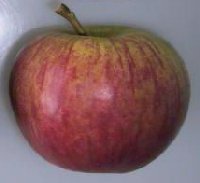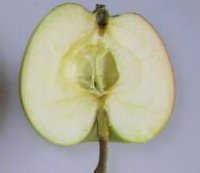PARENTAGE
The father is Cox’s Orange Pippin whilst the mother is Wealthy. The previous generation of Wealthy has a crab apple as the mother. Epicure was bred by Thomas Laxton (hence this variety is sometimes called Laxton’s Epicure) in 1909 and first sold in 1929. A sport of this variety (found in the 1950s) is Epicurean which is redder in colour although it is very rarely grown.
APPEARANCE, TASTE AND CHARACTERISTICS OF LAXTON’S EPICURE
The apples are slightly on the small size but this is more than made up for by the sheer number which are produced each year. With Cox in the parentage this variety has a good crunch to it with lots of juice. The taste is slightly sweeter than a Cox but at the same time it is just as refreshing.
As far as looks go this is a real beauty, combine that with its small size and you have an apple which children will love. The skin has a yellow background with good streaks of red and orange.

Epicure apple
The best taste comes from leaving the apples on the tree until they are just about to fall off. They can be cropped over a two week period but don’t keep well at all (in common with almost all early varieties), ten days at most. The inside is a light creamy white with pips that almost fall out of their own accord.
The tree is not a vigorous grower so it’s best bought on a fairly vigorous rootstock. We have noticed that the leaves are larger than normal although this poses no problems. Ripening times do vary depending on where you live so check out our dates section at the end of this article for accurate cropping times.

Disease resistance is fair to good with some sources reporting that it can suffer from bitter pit although the evidence for this is not clear. One other reported failing of Epicure is that as it ages it sometimes fails to crop each year. There does seem to to be clear evidence for this although this can be minimised to a large degree by thinning the fruit after apple drop in June. This variety stands late frosts well.
Pictures above from public sector information licensed under the Open Government Licence v2.0.
BUYING A LAXTON’S EPICURE APPLE TREE
You are unlikely to find this variety for sale at discounted prices, we have never seen one for sale in the supermarkets or DIY store. It is readily available online from several well known companies. Our recommendation would be to buy from R V Roger nurserymen, the price including postage is very competitive and they concentrate on personal service. They are a family run business from 1913.
SUMMARY CHARACTERISTICS OF EPICURE
USE: Early eating apple
SKIN COLOUR / TEXTURE: Red, orange / green background
FLESH COLOUR: Light creamy white
TASTE AND TEXTURE: Crisp, crunchy, aromatic and refreshing
FRUIT SIZE: Smaller than average
STORAGE: Two weeks
SUITABILITY FOR CORDON / ESPALIER GROWTH: Yes
TREE SIZE: A smaller than average tree, good for smaller gardens
REGULARITY OF CROPPING: Regular if thinned
POLLINATION: Group 3, self-fertile, see the list below for pollination partners
AWARDS: Not known
SPECIAL FEATURES: An excellent early variety producing lots of fruit. Good resistance to scab.
FLOWERING AND HARVEST TIMES
The average flowering time (optimum time for pollination) and date when fruits are ripe in the UK for Epicure are set out below. If you have set your home town we can give you a more accurate estimate, if you have not set your home town (do it now by clicking here) the dates below will be the average for the UK.
Your town has not been set, the average main flowering time for Epicure
in the UK is the first to second week of May. Fruit will be ready for harvesting in the last week of August.
Click here if you want to set the dates to your home town.
Flowering and fruit picking dates vary according to the weather in any particular growing season so the above dates may well change slightly from one year to the next. The flowering date above is when the apple tree produces the maximum number of blossoms, it will also produce blossom, although less, a week or two either side of the date given.
EPICURE APPLE TREE POLLINATION
We list below varieties which are suitable pollination partners for Laxton’s Epicure which is in pollination group 3 and self-fertile.
- Alkmene – pollination group 2, self-sterile, eater
- Arthur Turner – pollination group 3, self-sterile, cooker
- Beauty of Bath – pollination group 2, self-sterile, eater
- Bountiful – pollination group 3, self-sterile, cooker
- Braeburn – pollination group 4, self-fertile, eater
- Charles Ross – pollination group 3, partially self-fertile, cooker and eater
- Court of Wick – pollination group 3, self-sterile, eater and cooker
- Devonshire Quarrenden – pollination group 2, partially self-fertile, cooker
- Discovery – pollination group 3, self-sterile, eating and cider
- Dumelows Seedling – pollination group 4, self-sterile, cooker
- Egremont Russet – pollination group 2, partially self-fertile, eater and cooker
- Ellison’s Orange – pollination group 4, partially self-fertile, eater
- Falstaff – pollination group 3, self-fertile, eater
- Fiesta – pollination group 3, partially self-fertile, eater
- Gala – pollination group 4, partially self-fertile, eater
- Golden Delicious – pollination group 4, partially self-fertile, eater and cooker
- Granny Smith – pollination group 3, self-fertile, eater and cooker
- Greensleeves – pollination group 2, self-fertile, eater, cooker, juice
- Grenadier – pollination group 3, partially self-fertile, cooker
- Honeycrisp – pollination group 4, self-sterile, eater
- Howgate Wonder – pollination group 3, partially self-fertile, cooker and eater
- Idared – pollination group 2, self-sterile, eater
- James Grieve – pollination group 3, partially self-fertile, cooker and eater
- Katy – pollination group 3, self-sterile, both
- Kidds Orange Red – pollination group 3, self-sterile, eater
- King of The Pippins – pollination group 4, self-fertile, eater and cooker
- Lanes Prince Albert – pollination group 4, self-sterile, cooking
- Laxtons Fortune – pollination group 3, partially self-fertile, eater
- Laxtons Superb – pollination group 4, partially self-fertile, eater
- Lord Derby – pollination group 4, self-sterile, cooker
- Lord Lambourne – pollination group 2, self-fertile, eater and cooker
- Newton Wonder – pollination group 4, partially self-fertile, cooker
- Peasgoods Nonsuch – pollination group 3, partially self-fertile, cooker
- Rajka – pollination group 4, self-sterile, eater
- Red Falstaff – pollination group 3, self-fertile, eater
- Red Windsor – pollination group 2, self-fertile, eater
- Reverend W Wilks – pollination group 2, self-fertile, cooker
- Scrumptious – pollination group 3, self-fertile, eater
- Sops in Wine – pollination group 3, self-sterile, eater
- Spartan – pollination group 3, self-fertile, eater
- Sunset – pollination group 3, self-fertile, eater
- Tydemans Late Orange – pollination group 4, self-sterile, eater
- Waltz – pollination group 3, self-sterile, eater
- Winston – pollination group 4, self-fertile, eater
- Worcester Pearmain – pollination group 3, partially self-fertile, eater
The full list of apple tree varieties which we have reviewed is listed below. Select any one of them and then click the “More Information” button to be taken to the in depth review:
Rootstocks and Size
Guide to Planting
Care Plan
Pruning Apple Trees
Harvest and Storage
Pests and Disease
Pollination Groups
LAXTON’S EPICURE APPLE TREE
With hundreds and hundreds of different apple tree varieties grown in the UK it’s often difficult to pick any of the less well-known ones as worthy of space in your garden. Laxton’s Epicure however is an apple tree which stands out as having many excellent qualities.
Firstly this is an early variety producing apples from mid August to mid-September depending on where you live. It looks good, albeit slightly small, with a delicious taste. The tree keeps to a smaller than normal size but produces a larger than normal crop of apples.. This is a variety that is much under-appreciated and deserves to be grown more often.